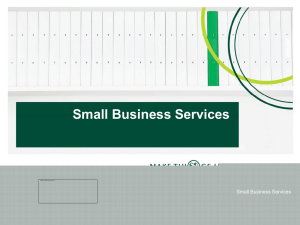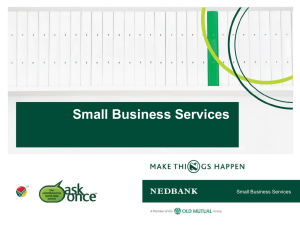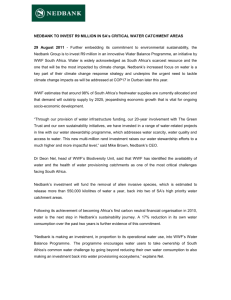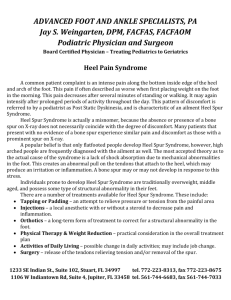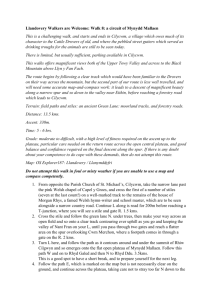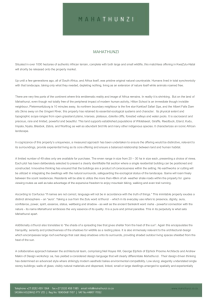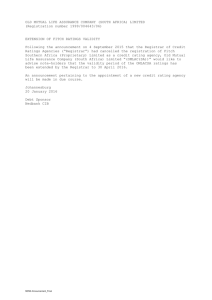THE CONCEPT OF STRATEGY
advertisement
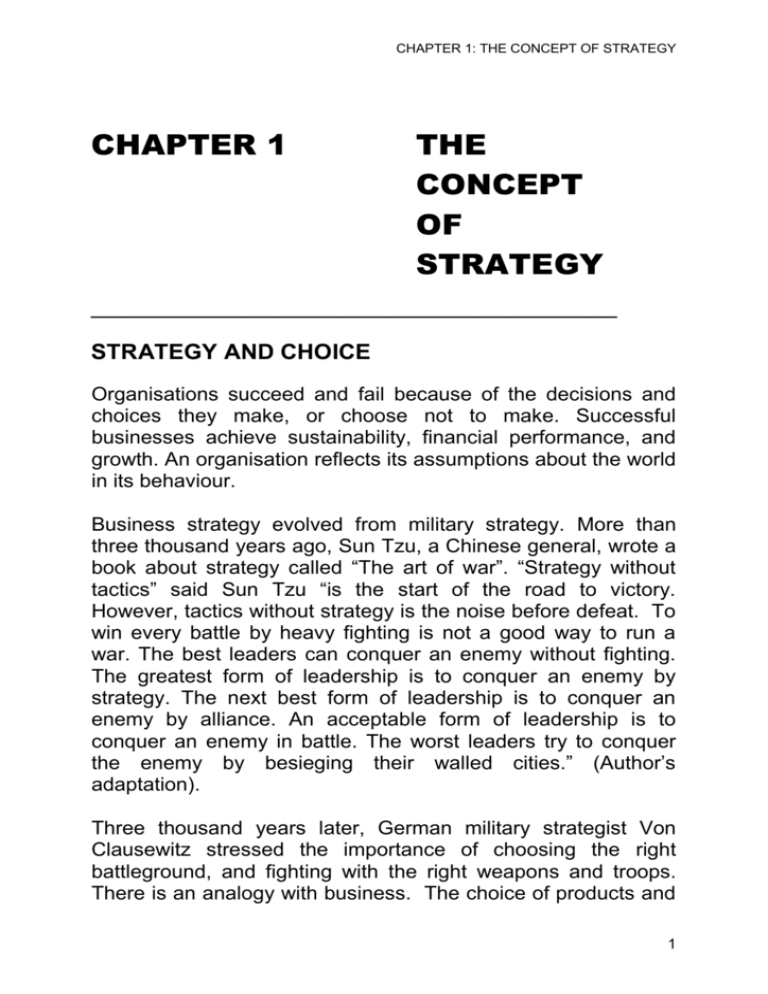
CHAPTER 1: THE CONCEPT OF STRATEGY CHAPTER 1 THE CONCEPT OF STRATEGY __________________________________ STRATEGY AND CHOICE Organisations succeed and fail because of the decisions and choices they make, or choose not to make. Successful businesses achieve sustainability, financial performance, and growth. An organisation reflects its assumptions about the world in its behaviour. Business strategy evolved from military strategy. More than three thousand years ago, Sun Tzu, a Chinese general, wrote a book about strategy called “The art of war”. “Strategy without tactics” said Sun Tzu “is the start of the road to victory. However, tactics without strategy is the noise before defeat. To win every battle by heavy fighting is not a good way to run a war. The best leaders can conquer an enemy without fighting. The greatest form of leadership is to conquer an enemy by strategy. The next best form of leadership is to conquer an enemy by alliance. An acceptable form of leadership is to conquer an enemy in battle. The worst leaders try to conquer the enemy by besieging their walled cities.” (Author’s adaptation). Three thousand years later, German military strategist Von Clausewitz stressed the importance of choosing the right battleground, and fighting with the right weapons and troops. There is an analogy with business. The choice of products and 1 CHAPTER 1: THE CONCEPT OF STRATEGY services, and the target markets to sell these in, defines the business battleground. The choice of weapons and troops equates to the business model an organisation uses to run a better operation than their competition. The business model embraces all the processes, policies, systems and controls an organisation uses to procure, manufacture and deliver its products or services to the markets of choice. IDENTIFY, UNDERSTAND, RESPOND Good business strategy arises from creative thinking. But creativity is in short supply. The planning cycle in many organisations encourages managers to focus on form rather than substance, and on outputs rather than ideas. The system does not guarantee right answers. In practice, some management teams consistently make better decisions. The difference is not a matter of luck. Good strategic decisions are made when an organisation has an innate, often intuitive, ability to identify, understand and respond to long-term changes in the environment and their industry. Those that are less strategically alert may fail to recognise the choices and issues that confront them in each of these three separate, but linked, activities. THE STRANGE STORY OF OK BAZAARS Sandton City changed the retail landscape in Johannesburg for ever, and was the genesis for shopping malls across urban South Africa in the 1980’s. In every town, retailers moved from the high streets to the malls when their leases expired. Accessibility and proximity also affected their business models. The trend towards supplying “anything you need or want” was reversed. Retailers focused their product offerings and their operations, specialising in groceries, or clothing, or furniture. But one retailer did not conform. OK Bazaars didn’t move to the suburbs. It remained a high street general dealer, offering a range of groceries, clothing, furniture, and home appliances in 2 CHAPTER 1: THE CONCEPT OF STRATEGY the central business districts of South African towns. Sam Cohen and Michael Miller opened the first OK in 1927, on the corner of Eloff and President Streets in Johannesburg. Over the next forty years this family business opened a hundred stores and OK’s logo became the country’s most recognised brand. OK’s growth and profitability attracted corporate attention. In 1973 South African Breweries bought out the controlling interests of the Cohen and Miller families in the largest retail transaction in South African history. Turnover and profits grew steadily for 15 years, and peaked in 1989. Then earnings declined, and continued to decline, year after year. OK’s 1992 annual report blamed a 27% drop in earnings on the “current recession” “escalating unemployment” and “continued socio-political unrest”, in a year in which competitor earnings grew. OK continued to run their stores in the country’s CBD’S, in spite of mounting losses. Breweries put OK up for sale. Local and international suitors arrived, contemplated, and left, but no deal emerged. In 1997 OK’s 187 department stores and 22 Hyperamas, on the brink of insolvency, were transferred to the Shoprite group for a token one Rand. Shoprite’s turnaround It was evident that OK could not be rebuilt. After his first visit to OK's head office, Shoprite’s Managing Director Whitey Basson reported that the organisation lacked a common culture. Major decisions were made for the benefit of particular stakeholder groups, not for the company as a whole. In addition, in an environment where information is critical, no credible information systems or business intelligence existed. Finally, costs were too high. OK was the only major retailer which ran its own advertising department instead of using an agency. OK’s advertising department employed 120 people; Shoprite had only six. 3 CHAPTER 1: THE CONCEPT OF STRATEGY Basson called for operating figures. The key “trading density” performance measure (or turnover per square metre), reported daily for each Shoprite store, could only be produced after a special investigation by OK’s accountants. The statistics were revealing. Compared to Shoprite, OK’s three key resources stores, merchandise and people - were badly managed, under utilised, and poorly controlled. Basson moved swiftly. He dismissed OK’s management, integrated their advertising with Shoprite’s, and invested millions in improved systems, controls and reporting. Many OK stores were rebranded and became Shoprites, Sentras, or franchises. The non core OK Furniture was sidelined. The OK takeover created opportunities for Shoprite to exploit synergies. The two businesses had similar target markets and product offerings. And Shoprite had capacity in the form of managers, supervisors and buyers. They didn’t need to build infrastructure to accommodate OK. They had good systems and tight controls, a major OK weakness. Shoprite was able to absorb the OK operations in to their existing infrastructure in each region. In 1999, just two years after taking control, Shoprite reported that OK had returned to profitability, with pretax earnings of five million. PRODUCTS AND MARKETS The first output of business strategy is the choice of future product and market scope. This defines the products you choose to sell in the future (or services you choose to render) and the markets you choose to sell them in. The product-market decision is complex and involves identifying market opportunities, understanding customer wants, observing competitor behaviour and monitoring industry developments. Akio Morita, founder of Japanese business empire Sony, said that when his managers had clarified those product categories 4 CHAPTER 1: THE CONCEPT OF STRATEGY and market segments they would focus on for long-term profitability and growth, they had formulated their strategy. By implication, those managers also devoted long hours and detailed analysis to deciding which product categories and market segments would not be part of their future, and were staking their careers and the investment of future capital on the correctness of their decisions. THE RAINCOAT WITH A CHECK Thomas Burberry was a weaver in Chichester in the 1850’s. By 1970 the Burberry family business was Britain’s leading manufacturer of top quality men’s and women’s rainwear. The Burberry name was a generic for top quality rainwear all over the world, enjoying the same brand recognition as Rolls Royce or Harrods. The garment was made of high quality water resistant gabardine, and the inside lining was patterned with the Burberry check – a marmalade coloured distinctive design, one of the few designs registered as a trade mark in the world. The company prospered until the late 1980’s, when sales and profits began to decline. The brand was not properly introduced to a new generation, and younger people associated Burberry with an earlier age, a garment worn by their parents or grandparents. In 1996, after years of poor performance, Burberry persuaded an American executive, Rose Marie Bravo, to become their new managing director. She had previously been the merchandise director of a leading US retailer, Saks of 5th Avenue. Her decision astonished the US market, who could not understand why she had left her lucrative position to run a failing business with an aging, tired brand. Ms Bravo’s initial analysis of Burberry was disconcerting. The raincoats were manufactured in the UK and were of excellent quality. Although expensive, there was little price resistance from existing loyal customers. The problem was to attract new 5 CHAPTER 1: THE CONCEPT OF STRATEGY customers. About 75% of the current sales were made to agents and retailers in Asia. Many successful people in Asia pursue a lifestyle which incorporates “only the best” - including the best raincoat. The Burberry brand enjoyed a fine reputation in Asia – but only among people over the age of 50. The market was declining, and the only way to increase sales and penetrate the younger generation in the Asian markets was through price reduction to compete with the imitation products on the market. However initial costings indicated that margins in Asia were already too low, and in most Asian countries Burberry was operating at a loss. The position in the United Kingdom was hardly better. Most sales were made to small localised family outfitters and gift shops. These distributors tended to stock only two or three garments at a time, with costly logistics and credit collection. Ms Bravo concluded that this customer segment was also unprofitable. The third and final market segment offered somewhat better prospects. About 10% of sales were to leading chain stores in the United States such as Neiman Marcus, Saks of 5th Avenue and Barneys. These sales enjoyed good margins but volumes were low and prospects for major sales growth were poor. Most Americans, including the higher income sector, tend to “buy American.” From her diagnosis it appeared to Ms Bravo that the odds against Burberry’s survival were insurmountable. In an interview some years later she said that as a full understanding of Burberry’s problems emerged, she was tempted on many occasions to abandon Burberry and return to the United States. But she did not. Instead, Ms Bravo confronted a reality that her predecessors avoided: a market segment that is not profitable, and shows no prospect of future profits, should be abandoned. 6 CHAPTER 1: THE CONCEPT OF STRATEGY Existing products in current markets Having investigated all other possibilities, Ms Bravo recommended that Burberry stop selling completely in both the Asian and the UK family outfitter/gift shop markets. The proposal to give up 90% of the existing sales base, was greeted with consternation by the Board as it was not possible to shrink the cost base accordingly. New products in current markets To replace the lost turnover, Ms Bravo planned to expand the product range. Raincoats are not the only garments that can be worn in wet weather. Ms Bravo employed a brilliant young fashion designer to develop a range of trench coats, umbrellas, trousers and other outerwear products. Existing products in new markets Harrods, the leading retailer in London, did not stock Burberry. Ms Bravo was successful in negotiating a listing for Burberry in Harrods and other exclusive retailers. Next she designed and opened her own Burberry stores throughout the UK. The flagship is in Oxford Street in London, and there are now 55 stores in the chain including a large duty free outlet at Heathrow. New products in new markets But these strategies on their own would not be enough to turn Burberry around. Ms Bravo’s prior retail experience had taught her that the biggest and most free spending market for fashion outerwear constituted, as she put it, “women between the ages of 28 and 38 who earn their own income.” This segment spends 3 to 4 times more than any other on fashion and beauty products. Bravo’s market research however indicated severe resistance to Burberry, being the “product our grandmothers wear.” Undeterred, Ms Bravo launched products aimed at this 7 CHAPTER 1: THE CONCEPT OF STRATEGY lucrative market. She developed a range of fashion items including cloaks, scarves, bags and even bikinis, which captured the youth market and resulted in phenomenal sales increases for Burberry. Burberry’s subsequent success is the stuff of legend. After returning to profitability, earnings grew at 200% pa compound for a number of years. Burberry became the leading fashion brand in the United Kingdom. In 2002 the company was successfully listed on the London Stock Exchange. Ms Bravo enjoyed a major financial benefit from the listing. In 2005 she retired from Burberry and is now the Chairperson of New York jeweller Tiffany’s. A BETTER RECIPE Businesses attract customers, staff and suppliers by satisfying their needs better than their competitors. The actions, policies, procedures and systems that make a particular business the “place of first choice” constitutes that company’s business model. A good business model attracts new people and organisations who want to be stakeholders. Stakeholders include all the people and organisations that use the product or service, and those who supply goods or services, including labour and capital. Stakeholders are also community and other interest groups who have views or concerns about what the organisation does. Each stakeholder group has to be satisfied for a business to be successful. The network of relationships built with these stakeholders constitutes a major and critical part of strategy. Customers are usually the most important stakeholders. Successful organisations understand how customers’ needs are changing, and change their business recipe to satisfy these changing needs. The customer’s perception is often as important as the underlying reality. 8 CHAPTER 1: THE CONCEPT OF STRATEGY SPUR STEAK RANCHES Sustainability is a key challenge in the fast food restaurant business. The typical life of many restaurant chains is about five years. Mikes Kitchen, Pizza Hut, Black Steer, Saddle Valley, O’Hagan’s burst forth, blossomed, then declined. Winners include Steers, Nandos, and KFC. But the longest survivor of all is a South African institution known to thousands of children as the Spur. Allan Ambor opened the first Spur steakhouse in 1967. Today Spur Steak Ranches is South Africa’s leading restaurant franchisor with annual sales growth of 20 % and operations in Australia, Ireland and the UK. Spur’s financial performance is remarkable. The share price has continued to rise over 20 years demonstrating investor confidence in Spur’s long term future. It has a strong balance sheet with no long term debt and substantial cash reserves. It can be argued that South Africa was ready for a steakhouse concept in the mid-60’s, and Spur just happened to be first in line. But Spur’s track record of 40 years in business, compared with the relatively shorter lives of many of their competitors, indicates that the company management was sensitive to change and adapted accordingly. Franchising Spur is run on a franchise basis. Restaurants don’t operate well with salaried managers and franchising combines ownership with management. It is also a source of finance, since franchisees provide their own capital and risk losing it if the business is not run properly. A franchisor has to guarantee the success of a person who was trained in a different industry. Spur helps potential applicants compile a business plan and assists with site selection and lease negotiations. They provide training, information systems and marketing. Regular store visits entrench high operating standards. Franchising is an important key success factor for a restaurant chain. Yet many 9 CHAPTER 1: THE CONCEPT OF STRATEGY failed restaurant chains also ran on the franchise concept. At the end of the day, Spur has a better business model. The place of first choice For millions of South African children, Spur is the place of first choice for a family meal outing or a birthday celebration. That did not come about by accident. It came about through painstaking attention to detail, understanding the often fickle and constantly changing wants of their target market, and designing a business recipe to meet those needs. Spur has developed a service offering that meets the needs of their target customer group. The product is not the food alone, and includes the entire experience for the family. Spur’s target market is the family, and within the family, the children are the primary decision makers. Spur understands the wants of children, in the context of a family food outing, better than any of their competitors. This market follows trends, and Spur has encounter groups around the country to identify, understand and respond to these trends. A year ago, there were no computer game terminals in Spurs. Today, every Spur has one. Spur also provides birthday treats, play areas, club membership, drawing sheets, toys and a host of other offerings. The children asked for them. Competitive advantage The business model extends beyond customers to meeting the needs of all stakeholders. Every business has at least four stakeholder groups: suppliers, shareholders, employees and customers. Successful strategists identify the sources of competitive advantage and focus obsessively on continuously improving their position. Since Spur is a knowledge-based business it has to be run by outstanding people. Spur’s people are the best in the industry. Over 90% of the head office staff have worked their way up the organisation after joining as waiters. Most employees are also shareholders through Spur’s share incentive scheme for managers and staff. 10 CHAPTER 1: THE CONCEPT OF STRATEGY In addition, Spur has developed a network of relationships with its franchisees, waiters, shop fitters, suppliers, shareholders and head office staff. Spur has captured the loyalty of these groups, firstly by providing fair economic returns to each, but over and above, by recognising and meeting the specific wants of each group. Fair money satisfies an economic contract but does not cement loyalty – Spur builds loyalty by making itself the “provider of first choice” for each of its stakeholder groups. Spur has over the years built its winning and adaptive business model by designing systems, policies and processes which deliver value to each of their stakeholder groups and thus build loyalty, including: Families, who are Spur’s target customer group, Spur provides a pleasant atmosphere with activities for children and a relaxing environment for parents, at reasonable prices. Waiters who know that Spur provides outstanding training, a congenial work environment and first time work exposure to business. Until legislation changed recently, waiters at Spur were not paid a fixed salary – remuneration was based on turnover and tips. There is a waiting list of young people seeking casual employment at every Spur restaurant. Franchisees that regard Spur’s service and support - training, legal advice, municipal regulations and backup – as the best in the industry. Staff members at Spur’s head office, including kitchen workers who prepare the Spur sauces, are shareholders and contribute their ideas to company plans and strategy. To see a good business model in action, visit the Spur. 11 CHAPTER 1: THE CONCEPT OF STRATEGY CORPORATE GOVERNANCE STRATEGY, VALUES, AND Corporate strategy precedes business strategy and is the function of the board of directors. Business strategy is the responsibility of the management team of each business unit. Corporate and business unit strategies are co-dependent in that each uses inputs from the other’s process. Cohesion is achieved by communication between head office and the units, and by designing a logical sequence for the planning process. The board’s mandate is, quite literally, to govern the corporation. But corporate governance on its own cannot make a company successful. Shareholders want more profits, year after year, yet expect the board to minimise risk. The challenge for a director is to balance conformance with performance. The board’s performance tasks as laid down in the King Reports on corporate governance include leadership and strategic direction, approving business plans, and monitoring performance. At the same time the board is required to protect the company’s assets and reputation, ensure compliance with laws, and identify and manage key risks. From a practical point of view, the long-term performance of a group board can be assessed against five key outputs: Building a balanced portfolio of businesses. The group board decides where to invest further capital, which businesses to hold, and which to sell or liquidate. Appointing the management teams that will run each division. The group board selects and develops leaders, builds management teams, motivates these teams, sets challenging projects that provide opportunities to grow, and designs reward systems. These teams solve the product and market challenges in the divisions. The search for new ventures, projects and investments. Fostering innovation through research and technology. Systems, controls, risk management and corporate governance. 12 CHAPTER 1: THE CONCEPT OF STRATEGY NEDBANK IN THE 1990’S The ultimate responsibility for what happened at Nedbank in the 1990’s is unclear. What is clear, however, is that the 2002 profit of R875 million was followed in 2003 by an operating loss of R1, 600 million. The bank had to be rescued with a R5 billion rights issue, underwritten by Old Mutual. Cape Town banker Tom Boardman was appointed to clear up the mess. By the end of 2005, the building blocks for the future were in place. Attributable profit to shareholders that year was R974 million and the ROE improved to 9.2%. Nedbank set a target ROE of 20% for 2007. Many companies changed their strategy in the 1990’s to fit the new South Africa. Nedbank, the banking arm of the Old Mutual group, wanted to be South Africa’s leading bank. Their strategy rested on four cornerstones: Information technology, customer profitability, the future of the Rand and diversification. Information technology Nedbank thought that banking and technology would converge. Branches would become obsolete over the next 10 years. Private and corporate clients would change their banking habits and adopt Internet, telephone and TV banking. Nedbank’s business model had to be changed to cater for the new era. The bank with the best technology would win. Nedbank’s management thought that Nedbank should buy equity stakes in leading technology companies, so they could be first to market with new technology. IT was too critical to be outsourced – Nedbank had to own its technology. The Nedbank Board approved the purchase of a major holding in Dimension Data, South Africa’s largest IT Company. IT stocks were booming all over the world. In addition to securing access to mission critical technology, DD was also believed to be an excellent investment. As an indication of confidence, the Nedbank management team proposed to base their performance 13 CHAPTER 1: THE CONCEPT OF STRATEGY bonuses solely on the Dimension Data share price over the next 5 years. Analysts and the financial press praised Nedbank for their strategy and the value it would create for shareholders, and investors were buying up Dimension Data shares in anticipation. The timing was tragic. Nedbank’s reading of the market was correct, but they were ten years too early. The speed of the technology revolution has been much slower than they anticipated. Nedbank bought Dimension Data at the top of the market. In 2003 the technology bubble burst. Customer profitability Outside consultants advised that Nedbank’s management accounting system could not measure customer profitability accurately. Their report recommended the introduction of the Activity Based Costing method of cost allocation to calculate true transaction costs. At a cost of some millions, new systems and people were put in place. Cost accounting is difficult in banking. Many costs are shared between business units. Nedbank’s new system introduced policies for cost allocation and transfer pricing, which they believed would lead to greater accuracy in measuring divisional profits and more accountability. The first ABC figures, reported in March 1997, confirmed the suspicion of many of Nedbank’s retail managers that they only made money from larger, mainly corporate, accounts. Most of this profit was then absorbed by the losses made on servicing the thousands of small personal accounts in Nedbank’s retail portfolio. The notion that most retail customers were unprofitable was not acceptable. Nedbank managers felt they had to “shrink the retail footprint” to remove unprofitable customers. As one manager said “The new costing system proves that a few large customers are subsidizing many small ones. We don’t want 14 CHAPTER 1: THE CONCEPT OF STRATEGY customers who lose us money, and it is immoral and bad business to expect our good clients to pay for our bad ones. We should focus on our most profitable clients.” The board approved a major policy change in the method of calculation of bank charges for smaller accounts, which in many cases would result in doubling or even tripling the small clients’ monthly charges. The retail division realized that this move would lead to some customers closing their accounts but estimated a very worst case scenario of 100,000 closures in the existing base of 1,200,000. It was felt that the fixed costs of Nedbank’s information technology infrastructure could easily be absorbed by the remaining client base. Over the next three years Nedbank closed more than a hundred retail branches and in fact lost 800,000 customers – many of whom were on an upward curve. But they had spent so much on technology they needed volumes and throughput to pay for their investment. How do you find 800,000 profitable customers quickly? They made a hostile bid for the biggest player in the industry, Standard Bank. The bid cost millions, and was rejected. Then, Nedbank decided to buy a much smaller bank, the Board of Executors. The purchase was financed by a fixed loan at high interest rates. The subsequent fall in interest rates only increased Nedbank’s problems. The future of the Rand By 1998 the South African Rand was in crisis. The Rand dollar exchange rate had risen sharply over the last three years and was sitting at 14 to the dollar and close to 20 to the pound. Clients were panicking and calling for advice. It was impossibly expensive to take out forward cover. One economist predicted that the Rand would weaken to 36 to the dollar and 50 to the pound. Investors, retired people and companies watched their capital drop to one third of its value in international terms in three years. Nedbank’s official view – in common with almost every South African bank – was that the Rand would continue 15 CHAPTER 1: THE CONCEPT OF STRATEGY to decline, as it had been doing for the last 20 years. Clients were advised to move as much of their funds offshore into hard currency areas, as they could. From a profitability viewpoint, Nedbank managers were convinced that the bank with the most money overseas in hard currency would yield the best returns over the long term. It simply made no sense to keep its stock-in-trade denominated in Rands. The board authorized the movement of as much of Nedbank’s capital as possible, into Dollar denominated investments, and into branches offshore. Nedbank’s managers were mandated to move every last cent they were permitted, in terms of South African exchange control regulations, offshore. Nedbank ended up with almost R9 billion of its capital in Dollar denominated investments, and infrastructure in branches offshore. The Rand then moved the other way. The purchase of Edward Nathan and Friedland Nedbank had a strong working relationship with a prominent law firm, Edward Nathan & Friedland. ENF was a tenant in Nedbank’s head office building and its senior partner, Michael Katz, sat on the Nedbank Board. The Merger and Acquisition practice of ENF advised on many of South Africa’s largest deals. Nedbank often provided finance and transaction support for these deals. Banks in the United States were diversifying by buying up stockbrokers, financial planners, tax advisors – and law firms. Nedbank managers wanted to pioneer this trend in South Africa and proposed a buyout of Edward Nathan and Friedland for R400 million. The ENF partners signed a 7 year service contract with the firm. The numbers showed that the purchase price would be recouped if only seven large deals were signed during this period. It was thought that the “deal flow” arising could make it the most profitable transaction Nedbank had ever entered into. Eight years later Nedbank sold ENF back to its partners for R80 million. The financial press queried Nedbank’s corporate governance. 16 CHAPTER 1: THE CONCEPT OF STRATEGY How could a bank commit so much of its capital to an investment in an IT company at the top of the IT bubble and then fail to respond to the subsequent drop in the share price? How could remuneration policies be tied to such a non core activity? How could potential customer account closures be underestimated by so wide a margin? What was the logic behind the purchase of Edward Nathan and Friedland? Did Nedbank not foresee the problems inherited in the BOE purchase? Was there no due diligence? Every bank took money overseas but only one bank took all its money overseas. It all pointed to poor risk management. Unwritten strategy Some companies have no written strategy because of the CEO’s personality and the prevailing corporate culture. Examination of past business decisions and behaviour reveals the strategy. Nedbank committed large sums of money to four risky investments – Dimension Data, BOE, the Rand and ENF. They withdrew from a major retail market, small individual accounts. Viewed holistically, these actions provide a window into Nedbank’s product-market strategies, their business model, and corporate culture. 17
